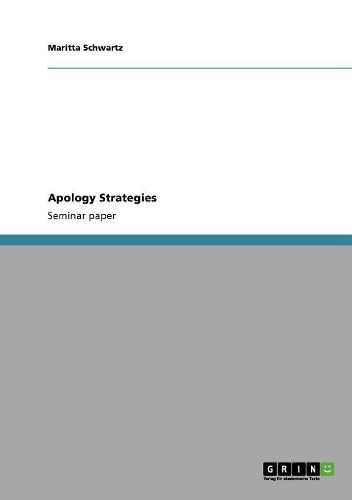Readings Newsletter
Become a Readings Member to make your shopping experience even easier.
Sign in or sign up for free!
You’re not far away from qualifying for FREE standard shipping within Australia
You’ve qualified for FREE standard shipping within Australia
The cart is loading…






Seminar paper from the year 1999 in the subject English Language and Literature Studies - Linguistics, grade: 1- (A-), Ruhr-University of Bochum (English Seminar), course: Proseminar: Pragmatics, 3 entries in the bibliography, language: English, abstract: Introduction In this paper we are going to deal with different theories concerning apology strategies. As there exists a variety of different theories, I chose just three of them for this paper. I will introduce their concepts, compare their differences and try to give a final evaluation of the three concepts. Blum-Kulka/Olshtain1 I will begin with the model of Shoshana Blum-Kulka and Elite Olshtain. They first of all classify apology as a speech act, name preconditions that are inevitable for an apology to take place and then list different strategy types. Apologie als a speech act: classification The apology belongs to the post-event-acts, i.e. it signals that a certain type of event has already taken place. Moreover, the speaker recognizes the fact that a violation of a social norm has been committed and that the speaker is at least partially involved in its cause. The involvement means a loss of face (= face threatening) for the speaker and is hearer-supportive.2 1 Blum-Kulka, S., Olshtain, E.; Requests and Apologies: A Cross-Cultural Study of Speech Act Realization Patterns in: Applied Linguistics, 5 / 1984. (p. 196-213) 2 ebenda, p. 206
$9.00 standard shipping within Australia
FREE standard shipping within Australia for orders over $100.00
Express & International shipping calculated at checkout
Seminar paper from the year 1999 in the subject English Language and Literature Studies - Linguistics, grade: 1- (A-), Ruhr-University of Bochum (English Seminar), course: Proseminar: Pragmatics, 3 entries in the bibliography, language: English, abstract: Introduction In this paper we are going to deal with different theories concerning apology strategies. As there exists a variety of different theories, I chose just three of them for this paper. I will introduce their concepts, compare their differences and try to give a final evaluation of the three concepts. Blum-Kulka/Olshtain1 I will begin with the model of Shoshana Blum-Kulka and Elite Olshtain. They first of all classify apology as a speech act, name preconditions that are inevitable for an apology to take place and then list different strategy types. Apologie als a speech act: classification The apology belongs to the post-event-acts, i.e. it signals that a certain type of event has already taken place. Moreover, the speaker recognizes the fact that a violation of a social norm has been committed and that the speaker is at least partially involved in its cause. The involvement means a loss of face (= face threatening) for the speaker and is hearer-supportive.2 1 Blum-Kulka, S., Olshtain, E.; Requests and Apologies: A Cross-Cultural Study of Speech Act Realization Patterns in: Applied Linguistics, 5 / 1984. (p. 196-213) 2 ebenda, p. 206